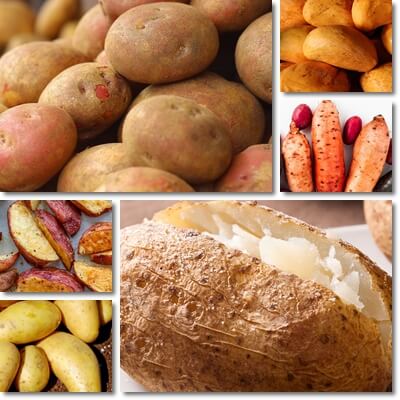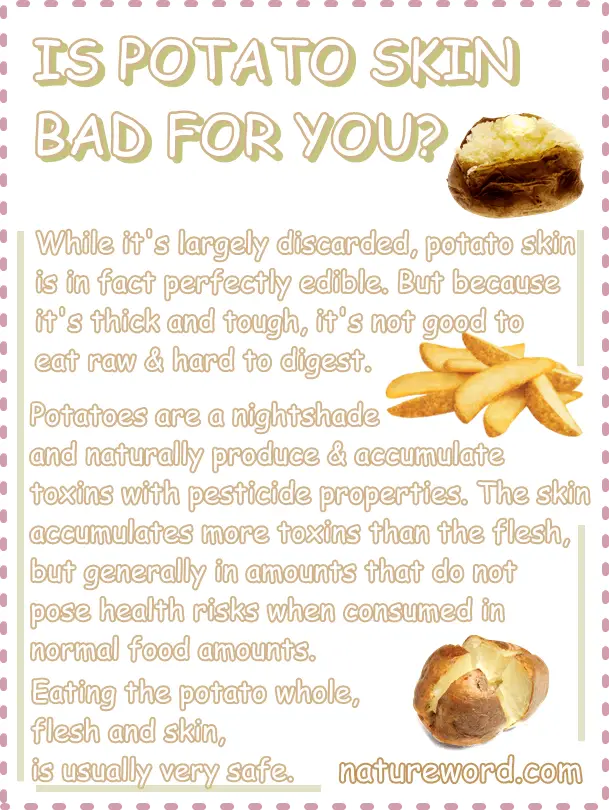Can you eat potato skin? Is potato skin safe to eat as in can you eat it without side effects? Is potato skin toxic or poisonous? How much potato skin can you eat safely without incurring risks to your health? Is potato skin edible raw or cooked?
Can you eat potato skin?
You can definitely eat potato skin, but the question is if it’s good for you to eat it! That is, are potato skins completely edible? How safe to eat are potato skins? Should you even be eating potato skin?
While it’s largely discarded, potato skin is in fact perfectly edible.
Despite potatoes naturally accumulating toxins in their skin, which, by definition, is dangerous for health, that is no impediment to consumption.

Is potato skin edible raw or cooked?
Technically, potato skin is edible both raw and cooked. However, potatoes are always cooked as cooking is the only way to render them acceptable for consumption and incentivize eating. Raw potatoes are tough and starchy, overall quite unpleasant to eat.
The skin on older potatoes is even thicker and tougher, quite impossible to eat raw and digest properly.
Cooking also serves several important purposes.
For example, cooking potatoes renders them soft which facilitates digestion.
Raw potatoes, skin and flesh, are both difficult to chew and difficult to break down during digestion due to their toughness. The starch in potato flesh is also very poorly digestible. If consumed raw, especially more than once, potatoes pose risks of bowel obstruction.
Cooking potatoes further makes them safe to eat because cooking heat destroy bacteria and other pathogens on the skin.
Potato skin is the barrier between the potato flesh and the outside and the part to get contaminated from contact with soil, contaminated irrigation water and from handling during the distribution process.
More important, cooking potatoes helps reduce the content of toxins in the skin and flesh.

Is potato skin toxic?
Potatoes belong to the nightshade family of plants, formally known as Solanaceae. Nightshades have a particular characteristic: the plants in this family produce toxins known as glycoalkaloids.
Potatoes too. The toxins accumulate in virtually all plant parts, in all plants of the family, but in varying amounts. And that is one the most important aspects of this conversation!
Potatoes naturally produce the toxins Solanine and Chaconine.
The two toxins represent the natural defense system of the potato plant and serve important roles: they act as a pesticide, antifungal agent and deterrent. The two toxins naturally accumulate in all the parts of the potato plant. But more in some and less in others.
Potato fruits (berries), flowers, sprouts, leaves and roots accumulate the highest amounts of toxins and are unsuitable for consumption.
They must not be eaten in any form! The high amounts of toxins they contain render them dangerous for health as in poisonous even in small amounts.
By comparison, the potato flesh normally contains the least amount of toxins.
The potato skin also accumulates toxins, but generally in amounts that do not pose health risks when consumed reasonably. Eating the potato whole, flesh and skin, is usually very safe when it’s consumed in normal food amounts.
Note: Under certain circumstances, even the potato can accumulate potentially dangerous levels of Solanine and Chaconine. Larger, older potatoes as well as potatoes belonging to certain cultivars, tubers stored improperly and exposed generously to sunlight, green potatoes and potatoes damaged physically tend to have greater than normal amounts of solanine, for example, which makes them not just bad to eat, but also dangerous for health.
Of course, this is rare and potatoes remain a generally safe food to eat. Do avoid potatoes that have lots of green on them, with both green flesh and green peel – these have more toxins and are more likely to be bad for you to the point of causing toxicity and potentially also death. Remove and discard green parts on your potato, flesh and skin, and always cook the tubers.
Studies show cooking potatoes removes the toxins which degrade at higher temperatures. According to research, cooking potatoes in the microwave can reduce their content of Solanine and Chaconine by 15%. Cooking such as frying and a temperature of around 170 degrees Celsius decomposes both toxins (consult sourced study).

Why are potato skins and flesh green?
The reason why potato skins and flesh are green is because they’ve been exposed to sunlight. While sunlight exposure does trigger the production of glycoalkaloids such as Solanine and Chaconine in potatoes, the green in the skins and flesh is actually chlorophyll.
So exposure to sunlight initiates chlorophyll production which is what causes the green color in potato skin and flesh. But the green color also indicates that exposure to sunlight has occurred which means that the potatoes are likely to have more glycoalkaloids. Green parts in a potato should be discarded and consumption avoided.
How safe to eat is potato skin?
When consumed in normal food amounts, potato skins are both edible and safe to eat. A lot of people usually eat potatoes with skin and, not only do they feel fine, but they also get additional nutrition from the skin.
Of course, do avoid potato skin that is green (flesh too), or too tough because these are bad for you. Also, if you do leave the skin on your potatoes with the intent to eat it, it’s good to get potatoes from organic agriculture which uses less pesticides.
How much potato skin can you eat?
There is no set amount, but you can simply leave the skin on the potatoes you do eat and that will be a good amount to eat safely.
Is potato skin bad for you in any way?
Potato skin is edible and safe to eat, as well as good for you because of its nutrition. However, there are instance when it is also bad for you. Eating raw potato skin causes indigestion with moderate to severe stomach upset.
Symptoms commonly include loose stools and diarrhea, painful abdominal cramps, excessive burping, bloating and gas.
The culprit is the tough fibrous material of the potato skin which is close to indigestible in raw form.
Also, eating too much raw potato skin can, in rare cases, cause bowel obstruction as the raw peel is tough fiber that humans don’t have the ability to digest very well. Peel parts may accumulate along the digestive tract and potentially cause obstruction.
Improper storage conditions, primarily exposure to sunlight, can lead to the accumulation of toxin levels above tolerated limits.
Green potato skins, and green flesh parts, should be avoided in the diet and discarded prior to cooking. Toxins from potatoes are dangerous for health as they are poisonous.
Also, if pesticides are used uncontrollably, it’s better to avoid eating potatoes with skin. Pesticides used in agriculture accumulate in plants, including in the edible parts such as the skin and flesh. Consumption of food ladled with pesticides poses many health risks, from feeling sick to higher risks of cancer.
Is potato skin good for you in any way?
Yes, potato skin is actually good for you. Potato skin is not something you eat just because it’s there. Considering it’s not even remotely palatable, there’s no incentive to eat it unless you do it on purpose, for its nutrition. Potato skin is actually a good source of nutrition.
The nutritional value of potato skins is remarkable as in it’s measurable, contributing to daily nutritional values. The skin has lots of dietary fiber, not many calories, no sugar and moderate amounts of carbs. Potato skins have calcium, iron, magnesium, phosphorus, potassium, sodium, zinc, manganese and copper, vitamin C, B vitamins and just 0.1% fat.
